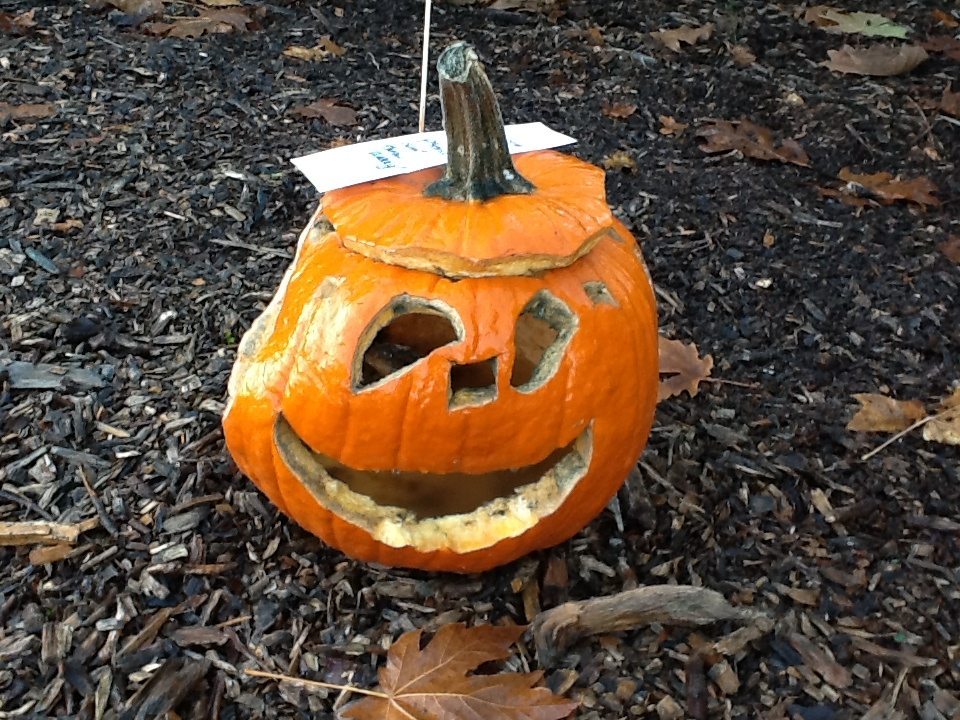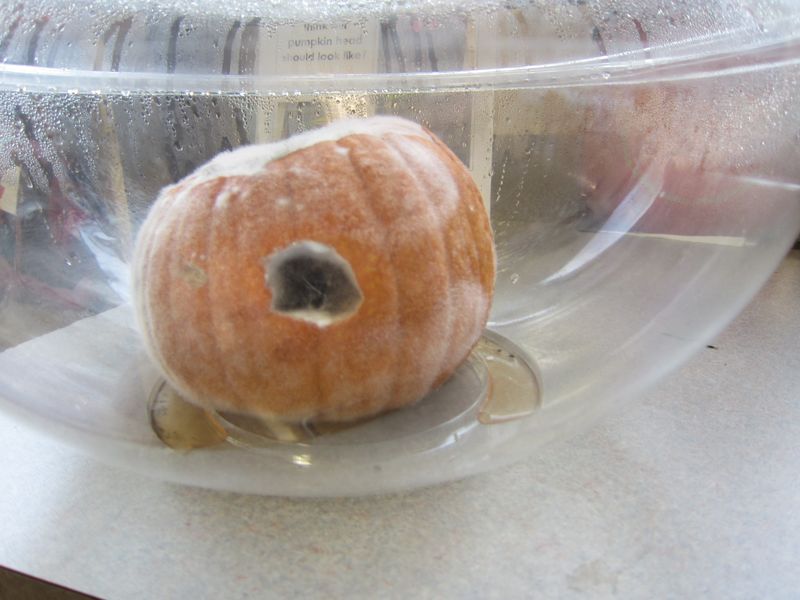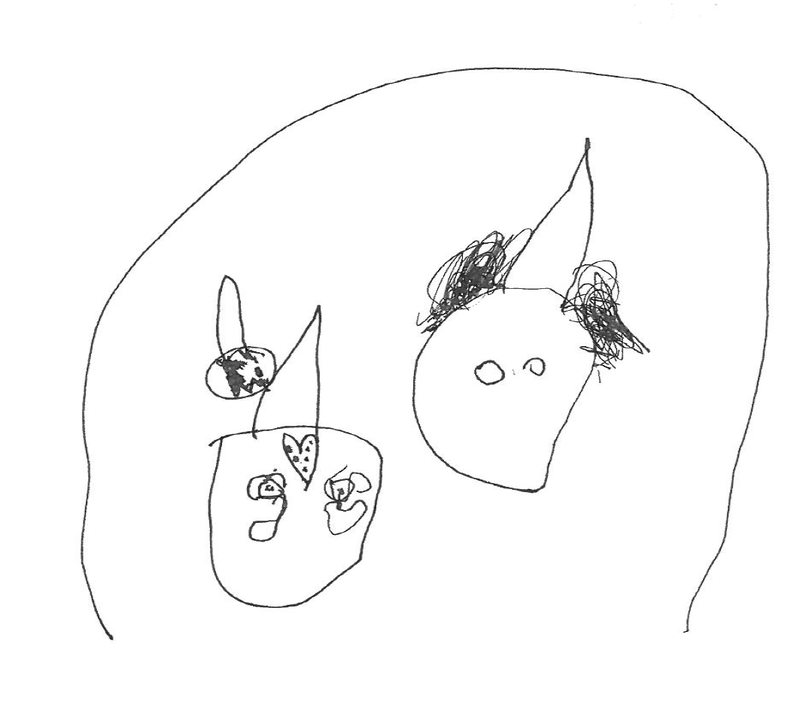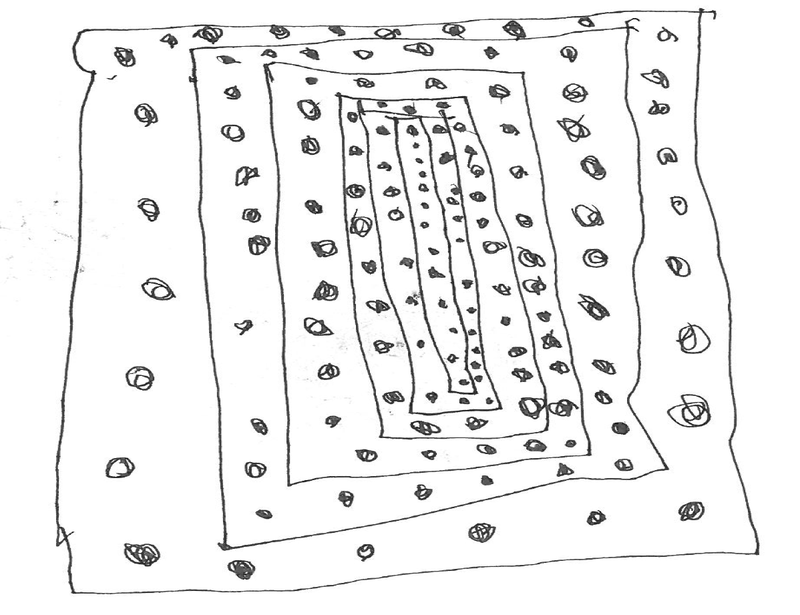Science Talk – Decomposing Pumpkins

Halloween came and went, as it always does, and with it so did the lovely pumpkins and jack-o-lanterns that help define and symbolize this exciting and spooky holiday. We kept our pumpkins around for a few days longer, but when we returned from the weekend break both of our jack-o-lanterns were showing extreme signs of decomposition. But instead of throwing them into the trash, we decided to keep them around and observe what happens to these seasonal gourds once their season is over. We put the little pumpkin in a container and kept it in the classroom…
and we brought the big pumpkin outside near the parking lot.
Then we waited. We watched. We noticed. We compared.
After a couple of weeks of checking on the pumpkins, we had a Science Talk to discuss the changes, the similarities and the differences we were observing. A “Science Talk” is a structure that we use where the children sit in a circle together and discuss a scientific question. This is just one effective tool to help children wonder about the natural world. By generating their own ideas and theories about the world, children become personally invested in seeking answers to those questions, thereby setting the stage for science
investigations. A good science talk will not only stimulate thinking, but will
stimulate children’s enthusiasm to discover answers on their own. In this particular talk, we decided to really zoom into what was happening to our two pumpkins. Together we shared what we noticed about what was happening and what they thought might happen to the two
pumpkins next.
investigations. A good science talk will not only stimulate thinking, but will
stimulate children’s enthusiasm to discover answers on their own. In this particular talk, we decided to really zoom into what was happening to our two pumpkins. Together we shared what we noticed about what was happening and what they thought might happen to the two
pumpkins next.
Here is a short excerpt of the children’s discussion:
T: Here is the question we are thinking about:
We had two pumpkins at Halloween. We had one of them and put them outside and one in this bin. And they are really different. What do you think is happening to the two pumpkins? Why is it so different? How come they are not doing the same thing? Who has an idea about what is happening or why they look so different. Maybe we can start by talking about what you notice?
V.D-B.: It’s getting fuzzy. The little one.
E.H.: This one (outside pumpkin) is not.
J.L.: There’s water in them. Both ones.
H.V.: Orange water (inside pumpkin). Yellowish water in the one outside.
S.S.: It’s going to melt. The one inside.
I agree with J. There’s water around it (inside pumpkin) and there’s water inside the pumpkin outside.
T: Do you think there’s water inside this pumpkin (inside)?
Jacqueline: Yes.
H.V.: There might be. But there’s mold in that one (inside pumpkin). Not in that one (outside pumpkin).
E.H.: But there is. Right inside of the pumpkin is mold. That one (outside) is black and that one (inside) is white. I know why. Because this one is inside and this one is outside.
O.L.: There’s black inside of that one!
O.R: There’s all fur inside the pumpkin.
O.L.:There’s black mold in the eye.
T: Does this black mold look the same than the one outside?
O.L.: It’s furry black mold (inside pumpkin) and this one is flat black mold.
L.S.: There’s no white mold on the back of the pumpkin (inside). And it only has one eye!
T: What is happening?
L.S.: Since that one (inside) is tinier the water went out and that one (outside pumpkin) is bigger, so the water stayed in.
M.W.: My pumpkin melted and these are getting older. These pumpkins are getting old like me and my friends. They are going to sink. They are about to. Mine got all rotty.
B.K.: The one inside can’t shrink because it is in the tub.
After thier whole group discussion, the children went to black-line pen and paper to think more about their ideas and theories.
“My pumpkin for Halloween. One is melting. They are going to melt because it’s getting old.”
-J.L., age 4
“I think the little dots of fur is making the water go in because the little white fur goes in pumpkins. Sometimes. The dots come from the scribbles of black things inside. The water goes into the white dot and come back out and goes into the container.“
-O.B., age 4
The purpose of the science talk is to support children’s interest and to inspire them to think like scientists by asking questions, offering ideas, listening and connecting to the ideas of
others, and making their ideas visible through a variety of art mediums. Materials such as clay, paint, collage, drama, and in this case, black-line pen are used by students to capture their ideas the theories and to bring their ideas and thinking further.


![2012-11-15 08.00.46[1] 2012-11-15 08.00.46[1]](https://opalschool.org/wp-content/uploads/6a0133f2cfa014970b017c33a7d798970b-800wi.jpg)

